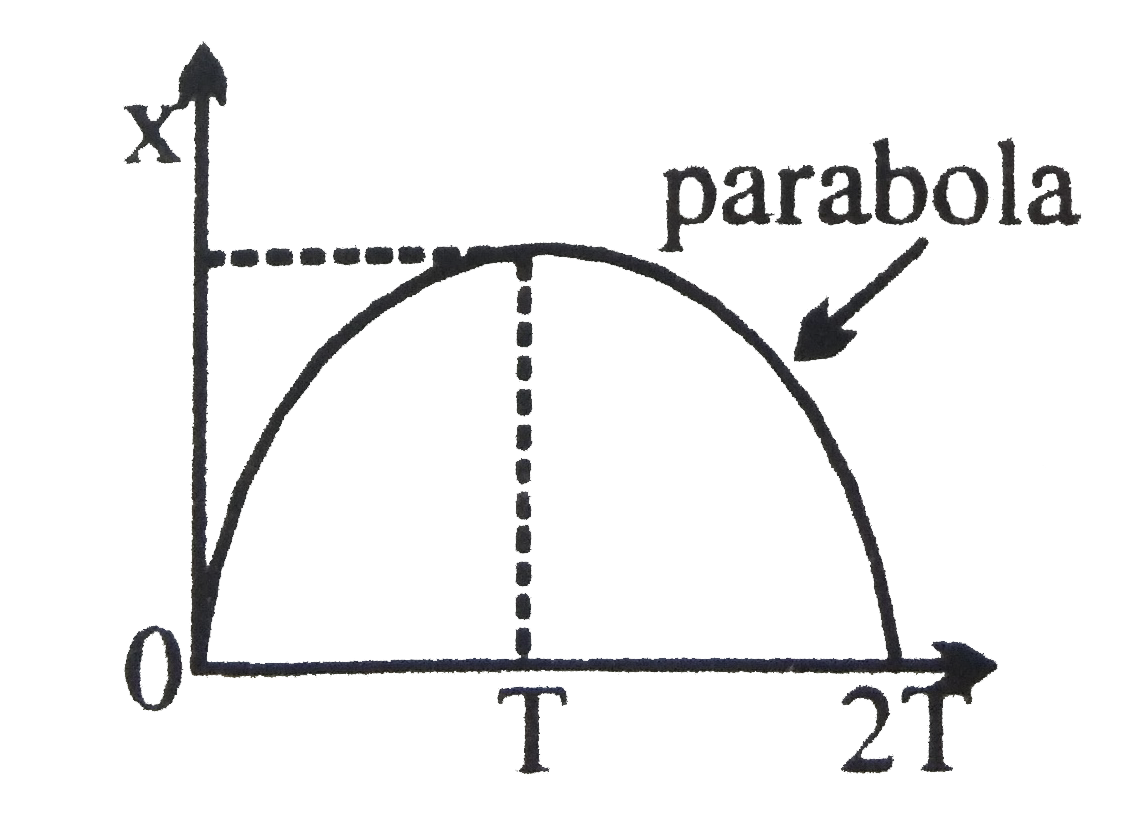A particle moves along a straight line . At a time (in seconds) the distance (in metre) of the particle is given by . How long would the particle travel before coming to rest ?
24 m
40 m
56 m
16 m
The correct Answer is:C
To solve the problem, we need to find out how long the particle travels before coming to rest. We are given the position function of the particle as:
x(t)=40+12t−t3
Step 1: Find the velocity function
The velocity v(t) of the particle is the derivative of the position function with respect to time t.
v(t)=dxdt=ddt(40+12t−t3)
Calculating the derivative:
v(t)=0+12−3t2=12−3t2
Step 2: Set the velocity to zero to find when the particle comes to rest
The particle comes to rest when its velocity is zero:
0=12−3t2
Rearranging the equation gives:
3t2=12
Dividing both sides by 3:
t2=4
Taking the square root of both sides:
t=2(since time cannot be negative)
Step 3: Find the distance traveled before coming to rest
Now, we need to find the distance traveled by the particle from t=0 to t=2.
1. Calculate the position at t=0:
x(0)=40+12(0)−(0)3=40 meters
2. Calculate the position at t=2:
x(2)=40+12(2)−(2)3
Calculating this gives:
x(2)=40+24−8=56 meters
Step 4: Calculate the distance traveled
The distance traveled by the particle before coming to rest is:
Distance=x(2)−x(0)=56−40=16 meters
Final Answer
The particle travels 16 meters before coming to rest.
---
The velocity v(t) of the particle is the derivative of the position function with respect to time t.
The particle comes to rest when its velocity is zero:
Now, we need to find the distance traveled by the particle from t=0 to t=2.
The distance traveled by the particle before coming to rest is:
The particle travels 16 meters before coming to rest.
Topper's Solved these Questions
- BOOK - A2ZCHAPTER - GENERAL KINEMATICS AND MOTION IN ONE DIMENSIONEXERCISE - AIIMS Questions20videos
GENERAL KINEMATICS AND MOTION IN ONE DIMENSION
- BOOK - A2ZCHAPTER - GENERAL KINEMATICS AND MOTION IN ONE DIMENSIONEXERCISE - Chapter Test30videos
GENERAL KINEMATICS AND MOTION IN ONE DIMENSION
- BOOK - A2ZCHAPTER - GENERAL KINEMATICS AND MOTION IN ONE DIMENSIONEXERCISE - Assertion Reasoning20videos
GENERAL KINEMATICS AND MOTION IN ONE DIMENSION
- BOOK - A2ZCHAPTER - FLUID MECHANICSEXERCISE - Chapter Test29videos
FLUID MECHANICS
- BOOK - A2ZCHAPTER - GRAVITATIONEXERCISE - Chapter Test29videos
GRAVITATION
Similar Questions
A particle is moving along a straight line OX, At a time t (in seconds) the distance x (in metres) of particle from point O is given by x=10+6t−3t2. How long would the particle travel before coming to rest?
View SolutionA particle moves along a straight line such that its positionx at any time t is x=3t2−t3, where x is in metre and t in second the
View Solution
Knowledge Check
- Question 1 - Select One
A particle moves along a straight line AB. At a time t (in seconds) the distance x (in metres) of the particle from O is given by x = 600 + 12t – t3. How long would the particle travel before coming to rest: -
A24mB40mC56mD16m - Question 2 - Select One
A particle moves along a straight line on y-axis. The distance of the particle from O varies with time and is given by : y=20t−t2. The distance travelled by the particle before it momentarily comes to rest is
A200 mB100 mC50 mD150 m - Question 3 - Select One
A particle is moving in a straight line. At time t, the distance between the particle from its starting point is given by x=t−9t2+t3. lts acceleration will be zero at
At=1 unit timeBt=2 unit timeCt=3 unit timeDt=4 unit time
A particle is moving in a straight line. At time t the distance between the particle from its starting point is given by x=t−6t2+t3. Its acceleration will be zero at
View SolutionA particle is travelling along a straight line OX. The distance r of the particle from O at a timet is given by x = 37 + 27t- t3, where t is time in seconds. The distance of the particle from O when it comes to rest is
View SolutionA particle moves in a straight line and its position x and time t are related as follows: x=(2+t)1/2
Acceleration of the particle is given byView SolutionIf S=16+(192)t−t3, then distance travelled by the particle before coming to rest is
View SolutionThe x−t graph of particle moving along a straight line is shown in figure

The v−t graph of the particles is correctly shown byView Solution

